Introduction
Domestic pigs are descended from the huge group of Artiodactyls, that includes hippopotamuses, camels, giraffes, antelopes, sheep, goats and cattle. They belong to the Suidae (swine) family. The pigs we see in farms today are most closely related to just one species of suid – the wild boar, or ‘wild pig’ (Sus scrofa). Wild boar once roamed Europe, Asia, North Africa and the Malay archipelago and their domestication first began over 10,000 years ago.1Caliebe, A, Nebel, A., Makarewicz, C. et al. 2017. Insights into early pig domestication provided by ancient DNA analysis. Sci Rep 7. The lifespan of a wild boar can vary between four to 12 years in the wild.2Marsan, Andrea; Mattioli, Stefano 2013. Il Cinghiale (in Italian). Il Piviere (collana Fauna selvatica. Biologia e gestione).pp. 83–86 In sanctuaries, they can live for up to 20 years as they have no predators.3Baskin, L.; Danell, K. (2003). Ecology of Ungulates: A Handbook of Species in North, Central, and South America, Eastern Europe and Northern and Central Asia. Springer Science & Business Media. pp. 15–38. On farms, they are usually killed after a few months.
Fascinating facts
Pigs are the fourth most intelligent animal on earth

They are smart, and sometimes smarter than, dogs, primates, dolphins and even human toddlers. They can even be taught to play computer games!4Croney, C.C. 1999. Cognitive abilities of domestic pigs. Thesis in Animal Science, The Pennsylvania State University, College of Agricultural Sciences, 1–105. Only the world’s most intelligent animals can recognise their own reflection and pigs may be members of this brainy club. In tests, piglets of just six weeks old used a mirror to locate food behind them that was only visible in the mirror, suggesting that they are aware of their reflection.5Broom, D. 2010. Cognitive ability and awareness in domestic animals and decisions about obligations to animals. Applied Animal Behavior Science, 126, 1–11.
Playful piggies!
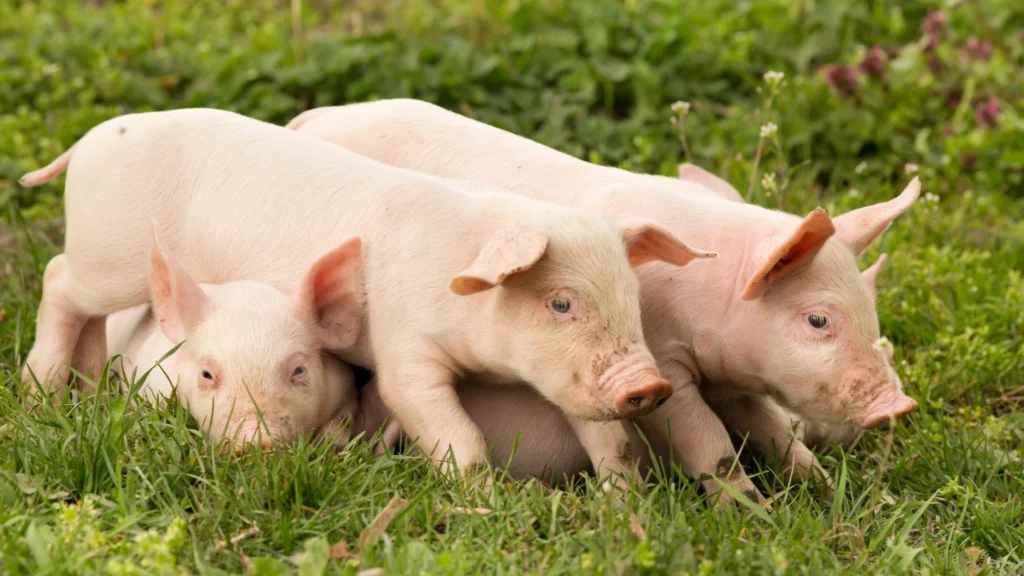
Pigs are incredibly playful and just like puppies, piglets will scamper, jump, hop, play-fight, push and run after each other! Adult pigs will run and dance with joy when given the freedom to do so. They also wag their tails when they’re happy! Pigs are extremely tactile and love nothing more than a good back scratch, massage or belly rub!6Marino, L., & Colvin, C. M. 2015. Thinking pigs: A comparative review of cognition, emotion, and personality in Sus domesticus. International Journal of Comparative Psychology, 28, Article 23859
Pigs are highly sensitive and emotional
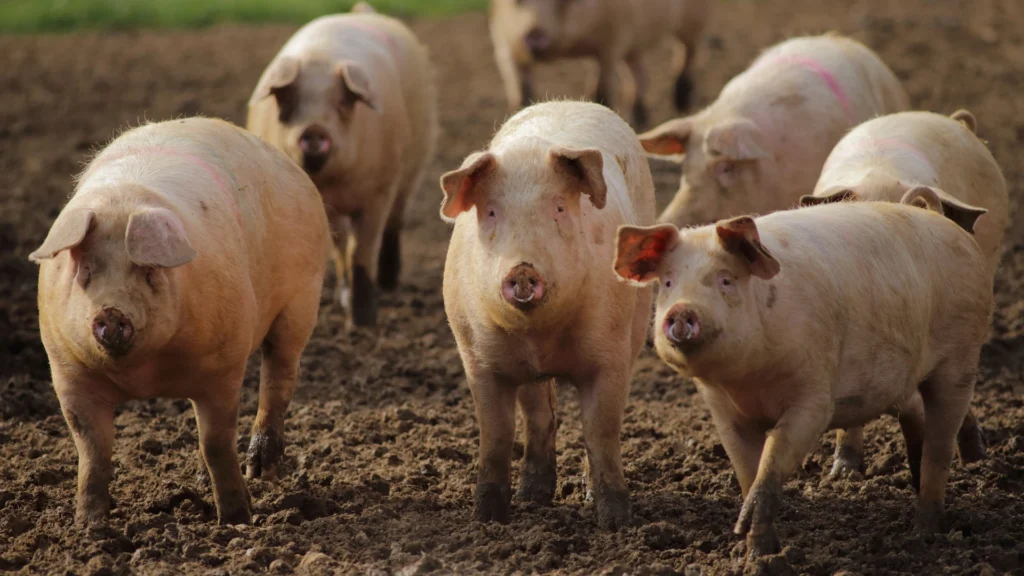
They pick up on the emotions of other pigs in their group and can feel empathy for them in the same way as other socially complex animals, such as the great apes.6Marino, L., & Colvin, C. M. 2015. Thinking pigs: A comparative review of cognition, emotion, and personality in Sus domesticus. International Journal of Comparative Psychology, 28, Article 238597Reimert, I., Bolhuis, J. E., Kemp, B., & Rodenberg, T. (2013). Indicators of positive and negative emotions and emotional contagion in pigs. Physiology and Behavior, 109, 42–50. Domestic pigs have even been known to come to the rescue of other pigs being harmed, and there have even been documented instances of farmed pigs trying to save one another from slaughter.8Masson, JM, 2019. The Secret World of Farm Animals. Vintage. P.26 9https://www.dailymail.co.uk/news/article-5259419/Pig-rescues-friend-thats-slaughtered.html
Pristine pigs

Despite their reputation as being dirty, pigs are very clean and hygienic. Even a one-day-old piglet will leave the warmth of his or her mother to urinate away from the nest.10Doherty J. 2010. The Private Life of Pigs. BBC Two. Available at: https://www.bbc.co.uk/programmes/b00t3tl1 That’s more than can be said of human babies! In fact pigs, like elephants, enjoy mud baths to protect their skin from the sun, to help rid of parasites and to cool them down. They do not like being forced to stand in their own excreta!
A super sense of smell
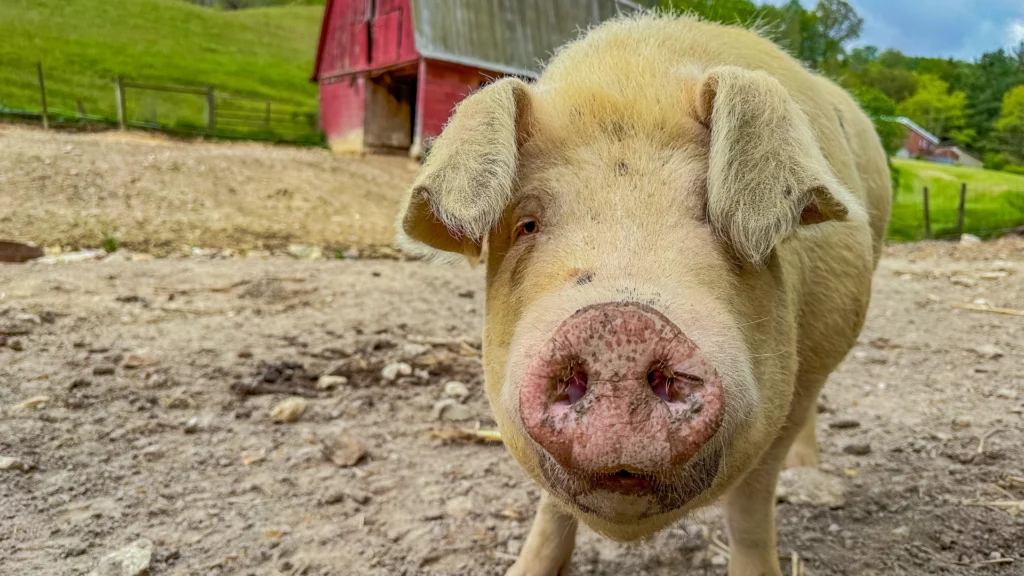
A pig’s sense of smell is 2,000 times more powerful than a person’s. They can smell a human up to a quarter of a mile away and locate roots and tubers that are deep underground.6Marino, L., & Colvin, C. M. 2015. Thinking pigs: A comparative review of cognition, emotion, and personality in Sus domesticus. International Journal of Comparative Psychology, 28, Article 2385910Doherty J. 2010. The Private Life of Pigs. BBC Two. Available at: https://www.bbc.co.uk/programmes/b00t3tl1 This is why some pigs have been trained to find truffles, considered a fine-dining delicacy, in the forests of Europe and the United States.
For the love of a sow
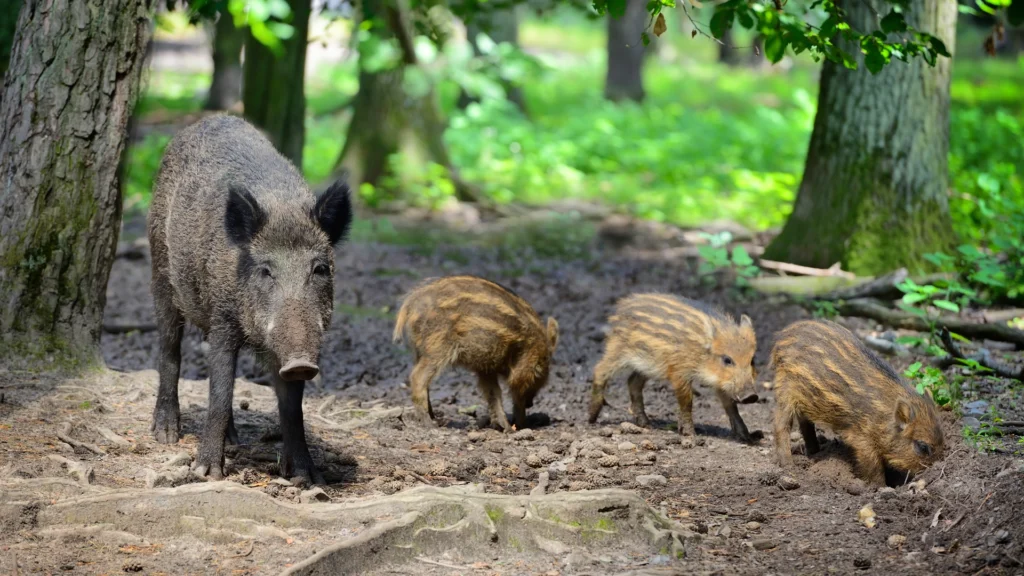
Wild boars live in groups called ‘sounders’, usually made up of six to 20 pigs. Adult males will only visit the sounder to mate (although they may stay nearby), so sows travel in matriarchal groups made up of one or two adult female sows and their litters. Males travel long distances to find females with which to mate, and will fight rival males for mating rights.
Protective mothers

Sows are usually pregnant for between 114 and 140 days, depending on her age. When she is about to give birth, she will build a nest out of twigs and vegetation. The average litter size in the wild is between four and seven piglets. When born, they latch on to a teat and within 48 hours will have a ‘teat order’ and from then on, every piglet will stick to his or her own individual teat until weaned.8Masson, JM, 2019. The Secret World of Farm Animals. Vintage. P.26 Female boars are very protective and share maternal duties. If a sow dies prematurely, others sows in the sounder will adopt her babies.2Marsan, Andrea; Mattioli, Stefano 2013. Il Cinghiale (in Italian). Il Piviere (collana Fauna selvatica. Biologia e gestione).pp. 83–86
Pitch perfect pigs
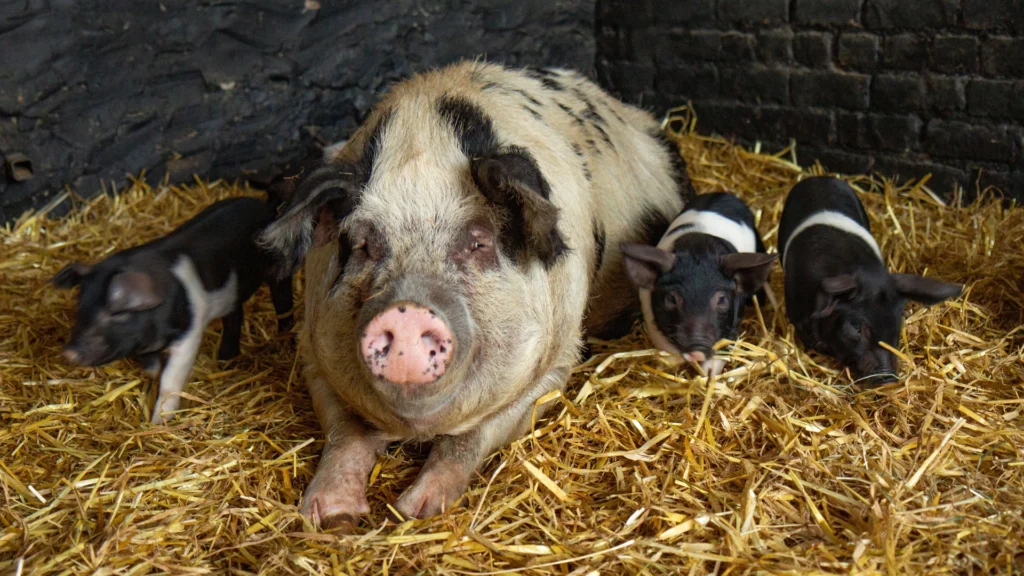
A mother pig (sow) will ‘sing’ to her babies while nursing, making particular and continuous grunts which get faster until their milk stops flowing. New-born piglets learn to run to their mum’s voice.11Algers, B & Jensen, P. 1985. Communication during suckling in the domestic pig. Effects of continuous noise. Applied Animal Behaviour Science. 14, 49-61
Back to their roots
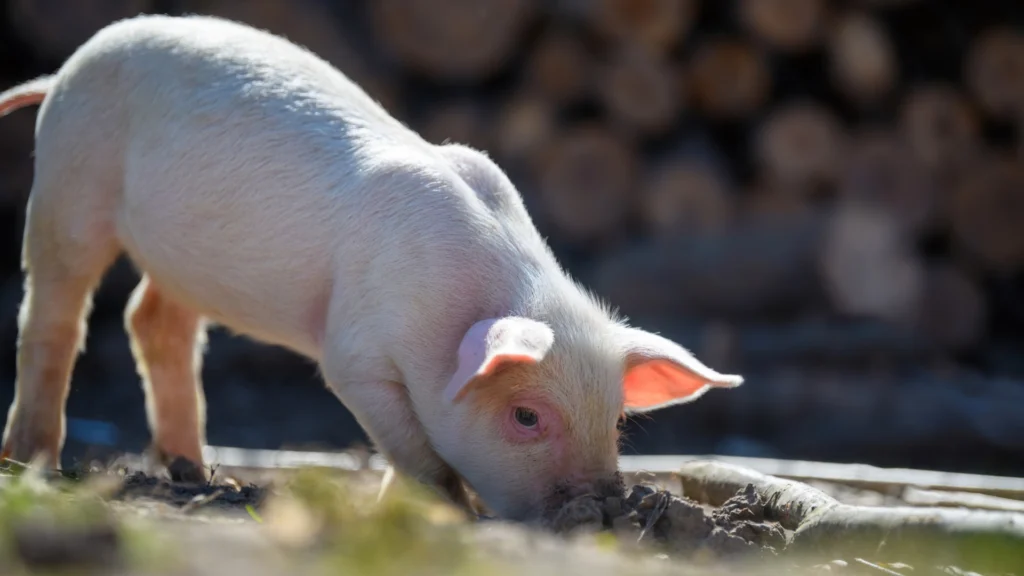
‘Rooting’ is the natural behaviour of pig’s disturbing the soil or mud by pushing with their snout in search of food. In the wild, they will push up roots to eat, turning over and churning up the soil as they do so. Wild boar are wide-roaming and mostly active in the early morning and late afternoon. They spend between four and eight hours a day rooting and foraging, sometimes travelling over thousands of hectares in a matter of months to find fresh food. The rooting instinct is just as powerful in commercially farmed pigs, but sadly is often denied causing frustration and depression.
Pigs in Uganda
Pig farming is one of the fastest growing farming practices in Uganda.12https://www.ed.ac.uk/roslin/eeragroup/research/pigboost It is encouraged as a way to increase meat, income and employment, however we also need to look at the long-term health of the people and the planet. And the impact on the animals themselves.
How much pig meat is eaten?
Pork is a popular meat amongst Ugandans, and as the population grows, so does the demand for pigmeat. In 1962, the average person was eating 0.14 kilograms of pork a year, but by 2013 this had increased to 3.37 kilograms, making Uganda the biggest consumer of pork in East Africa.13https://link.springer.com/article/10.1007/s11250-018-1668-6 Today, this number is estimated to be closer to 3.5 kilograms per person14https://www.sciencedirect.com/science/article/pii/S2211912418300968, and pork consumption is expected to increase by 184 per cent between 2000 and 2030 due to the growing population.13https://link.springer.com/article/10.1007/s11250-018-1668-6
How many pigs are killed?
There are currently between 3.2 and 5 million pigs13https://link.springer.com/article/10.1007/s11250-018-1668-615https://www.harvestmoney.co.ug/pigs-get-modern-abattoir/, confined mainly on 1.1 million small-scale farms across Uganda.16https://news.ilri.org/2014/02/19/ugandans-and-pork-a-story-that-needs-telling/ In 2020, Uganda produced 131,200 metric tons of pork and this is expected to increase significantly in the coming years.17https://www.statista.com/statistics/1290476/production-volume-of-pork-meat-in-africa-by-country/ In 2022, 2,091,065 pigs were slaughtered in Uganda.18https://www.fao.org/faostat/en/#home
Until recently, there was only one official pig slaughterhouse in Uganda: Wambizzi in Kampala19https://core.ac.uk/download/pdf/132689008.pdf, authorised by Kampala Capital City Authority but a more modern abattoir has now been built in Vvumba.15https://www.harvestmoney.co.ug/pigs-get-modern-abattoir/ Between July 2011 and June 2012, nearly 20,000 pigs were slaughtered at Wambizzi abattoir but this only accounts for a small percentage of the pigs killed. Most other pigs are killed and butchered in unmonitored and unhygienic conditions at unofficial local backyard slaughter points.20https://www.ncbi.nlm.nih.gov/pmc/articles/PMC10239858/ In towns where there is a government-approved slaughterhouse, it is illegal to slaughter animals elsewhere21https://www.parliament.go.ug/cmis/browser?id=a2b173a3-bab6-40f1-9d78-c2edc3d48b5f%3B1.0 but as there are so few official slaughterhouses, backyard slaughter is still common across Uganda. Even if your meat comes from an approved slaughterhouse, there is no guarantee it is safe for consumption.22https://www.monitor.co.ug/uganda/lifestyle/reviews-profiles/where-is-your-meat-coming-from–1519892
How pigs are farmed

Pigs in Uganda are mainly farmed on small-scale household farms. Around 70 per cent of Ugandan households partake in small-scale animal farming13 https://link.springer.com/article/10.1007/s11250-018-1668-6 and, according to the FAO, 20 per cent of these farm pigs. As of 2018, most farming households (66 per cent) only had one or two pigs, 23 per cent had two to five, and 11 per cent had five to 15 pigs.23https://www.fao.org/3/i7503e/i7503e.pdf However, farms of 20 to 40 sows are becoming more common24https://www.devenishnutrition.com/international/devenish-uganda-project, and the more intensive – Sanyu Piggery Farm in Vvumba contains 1,600 pigs awaiting slaughter.15https://www.harvestmoney.co.ug/pigs-get-modern-abattoir/
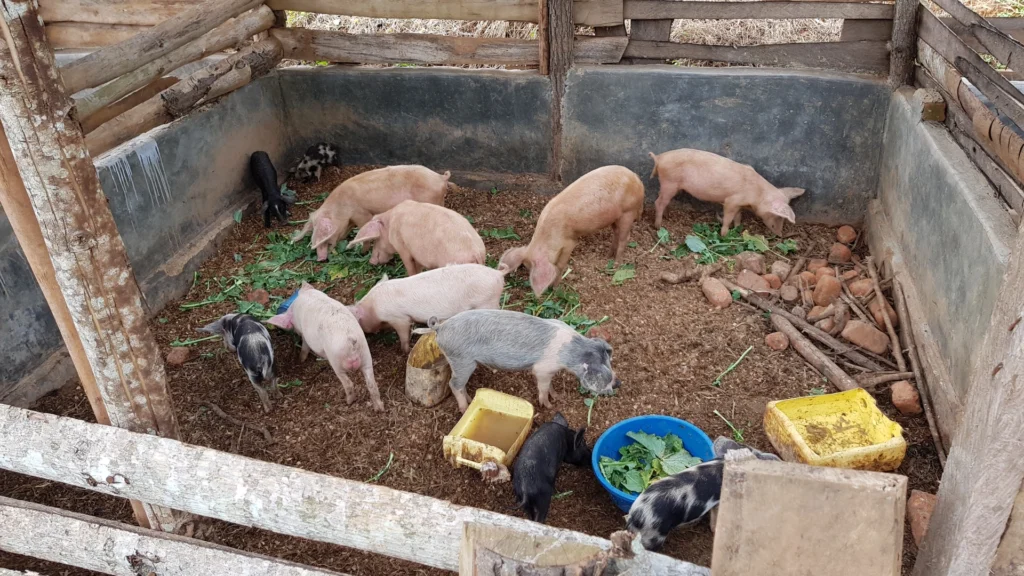
The day-to-day management of the pigs on household farms is usually in the women’s hands while the men take responsibility for the business side of the operation.16https://news.ilri.org/2014/02/19/ugandans-and-pork-a-story-that-needs-telling/ Pig farmers are untrained, have very few resources and have little understanding of the needs of pigs. The pig has no protection in Uganda so they are kept in varying degrees of confinement. Some are tethered to one spot, others are allowed to roam ‘free-range’, while some are restricted of all movement, confined to small crates.20https://www.ncbi.nlm.nih.gov/pmc/articles/PMC10239858/
Many who keep the pigs in pigsties, confine the pigs at night but let them roam freely during the day. Roaming pigs are not in their natural habitat of woodlands and are at “considerable risk of disease”20https://www.ncbi.nlm.nih.gov/pmc/articles/PMC10239858/, including intestinal worms and porcine cysticercosis – an infestation of tapeworms that can cause serious health problems in humans.

Pigs are fed on leftovers from the crop harvest and kitchen scraps. Usually the stalks, leaves and other residues after grain has been harvested for human consumption. This is not enough to keep the pigs well-fed and in good health. An inspection of Ugandan pigs revealed that they are “exposed to severe undernutrition, dirty water, high mortality, physical injuries, poor housing, and health challenges.”25https://www.frontiersin.org/articles/10.3389/fanim.2022.878359/full
The inspection revealed that nine per cent of sows had diarrhoea and lameness, 20 per cent of sows were restricted of all movement in crates, still births and piglet deaths were common, clean water was available less than half of the time, and a staggering 92 per cent of pigs were underfed and underweight.25https://www.frontiersin.org/articles/10.3389/fanim.2022.878359/full
A Viva! inspection of a pig farm in Uganda in 2023 found that pigs were undernourished and permanently confined on concrete floored pens. They had no enrichment and showed signs of mental distress and boredom.

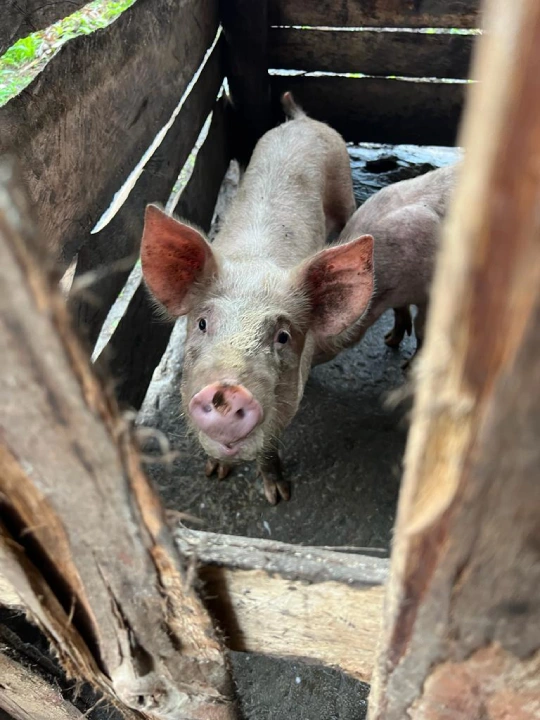
Unlike in China and developed Western countries, most of the pigs in Uganda are spared from the horrors of industrial-scale intensive farming, but they face their own nightmare.
Mutilation of piglets

From the moment they are born, piglets experience a horrific entry into the world.
The practice of “teeth clipping” is a particularly brutal one. As soon as a piglet is born, they will have their mouth forced open and the ends of their teeth broken off with a pair of clippers.26https://www.monitor.co.ug/uganda/magazines/farming/five-things-you-should-do-for-pigs-1830712 The reason behind this is that piglets have sharp teeth and if they bite the sow’s teats she may stop feeding them. However, this would not happen if sows were allowed to raise their piglets naturally instead of being confined to a crate.

Piglets also have to endure the torment of tail docking. Because pigs are kept in cramped, overcrowded and boring conditions, they display unnatural behaviour such as chewing and biting the tails of the pigs around them. Instead of giving the pigs better living conditions, they have their tails chopped off.26https://www.monitor.co.ug/uganda/magazines/farming/five-things-you-should-do-for-pigs-1830712 Before the piglet is even a few days old, they have their tail cut off at the base with a pair of clippers. If the tail is cut too short it can lead to infections and prolapse, which means the insides of the piglet start to come out of their anus. The dirty conditions on a pig farm also mean the wound could easily get infected and kill the poor piglet.
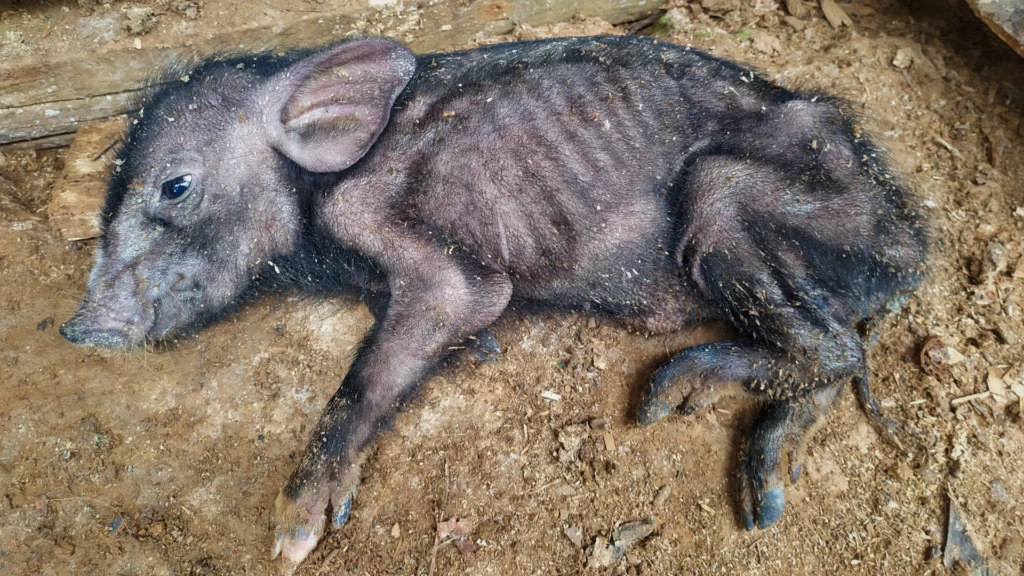
How pigs are killed
Pig slaughter in Uganda either takes place at the official slaughterhouses, approved by the Government, or at the many unofficial ‘backyard slaughter’ points.20https://www.ncbi.nlm.nih.gov/pmc/articles/PMC10239858/
Slaughterhouses
Until recently, there was only one official pig slaughterhouse in Uganda19https://core.ac.uk/download/pdf/132689008.pdf but its ‘official’ status means little to the pigs who are subjected to the horrendous cruelty inflicted on them there. The pigs’ experience from their arrival to their death is like something out of the worst horror film imaginable.
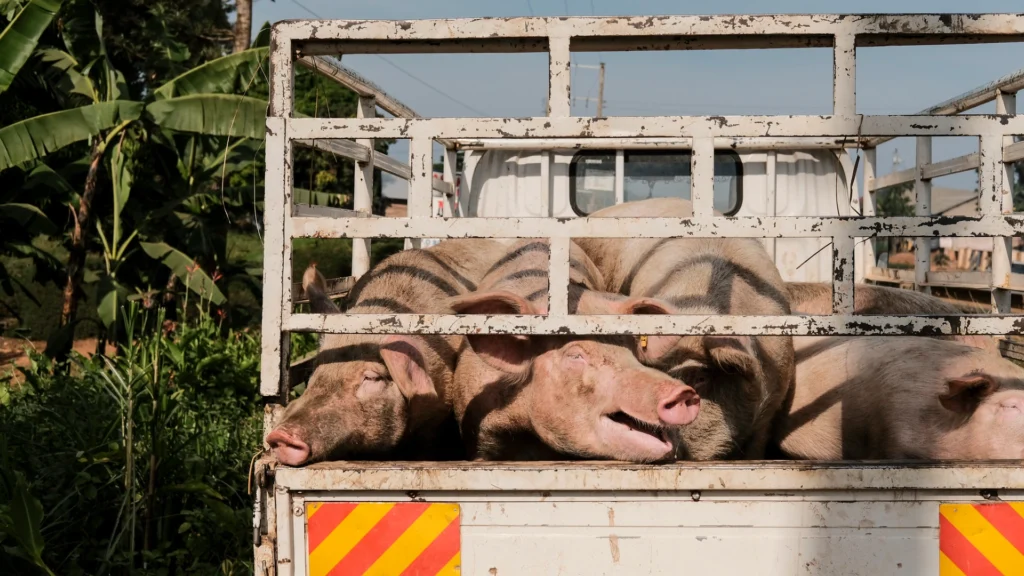
First, pig traders buy the pigs they want from the farms and then send them to be killed. The unfortunate pig is grabbed by the tail or ears and pulled to the slaughterhouse. The poor pig is then shoved or kicked into a pit to await his death with the other victims. When the slaughterman is ready, he jumps down into the pit and repeatedly hits the pig to force him out of the pit and towards the killing floor. At this point, the slaughterman lifts the squealing pig and throws him violently down on his side, grabs a leg and places his foot on the pig’s body to keep him pinned down. Then, using a sawing motion, the slaughterman cuts the pig’s throat. All the while the pig is screaming in pain until the slaughterman’s knife reaches the trachea, and the screaming becomes a horrible gurgling sound as the pig chokes on his own blood. The death is not quick and certainly not painless. The pig is left to thrash on the floor for minutes, dying in a pool of his own blood and faeces.
After between 10 and 30 minutes, the dead pig is unceremoniously thrown into a boiling tank, with several other victims. When the hair of the pig can easily be removed, he is pulled out of the tank with a grappling hook and dragged back through the blood and faeces on the floor and to another area to have his hair removed. The pig’s large hairs are very roughly scraped off, and then a razor blade is used to remove the finer ones.
Once the hair has been removed, the slaughterman slices through the pig’s leg so he can be hung up on a hook. A machete is used to hack off the pig’s feet, his tail is chopped off and then the slaughterman rips out all of the pig’s internal organs, which are either chucked on the filthy floor or thrown into different buckets. The pig carcass is then ‘cleaned’ with water and stamped by an inspector to say it is fit for human consumption. Once approved by the inspector, the pig is decapitated and weighed.19https://core.ac.uk/download/pdf/132689008.pdf
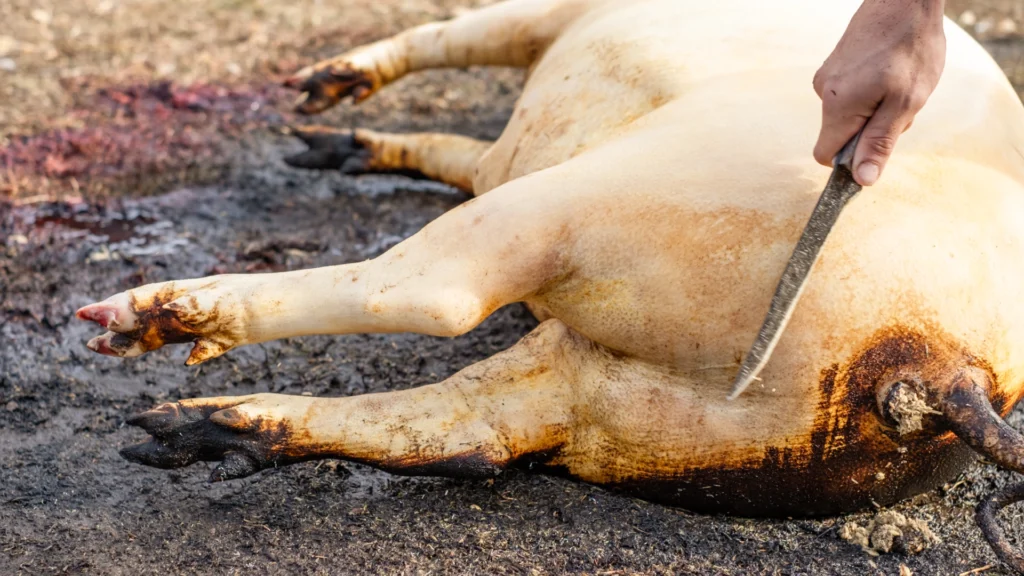
Most slaughterhouses in Uganda operate as described above, but due to public health concerns, Uganda is starting to see more modern slaughterhouses. Mbizi abattoir in Wakiso district is a modern slaughterhouse that electronically stuns the pigs and uses machines to cut their throats.15https://www.harvestmoney.co.ug/pigs-get-modern-abattoir/ A device a bit like a large pair of tongs is used with an electrode on each end. These electrodes are clamped on either side of the animal’s head and an electric current is passed through the brain, supposedly making the animal unconscious. But, there are too many things that can, and often do, go wrong – the current is too weak, the slaughterer does not apply the electrodes to the correct part of the head, and fails to hold them in position for the required length of time to make the stun properly effective. The result can be that the stun is short-lived and the animal regains consciousness before his or her throat is cut. Viva! has filmed this happening with both pigs and sheep in the UK.
Backyard slaughter
With backyard slaughter, the pig trader or ‘pork joint’ owner decides where to kill the pig and just carries them back to the butchery or pork joint to sell the meat.20https://www.ncbi.nlm.nih.gov/pmc/articles/PMC10239858/ Because this is done away from prying eyes, the meat is almost never inspected to make sure it is safe to eat… and it almost never is! One meat inspector said that a quarter of pigs that are slaughtered have pork tapeworm cysts in their muscles, but most inspectors don’t even know what they’re looking for anyway.20https://www.ncbi.nlm.nih.gov/pmc/articles/PMC10239858/
Backyard slaughter is very much like the killing described in the slaughterhouse above, but with even less care for the pig and hygiene. Pigs will violently have their throat slit by rusty blades and their innards hacked out with a machete. They are then left to ‘bleed out’ on dirty ground, rife with bacteria and parasites. There is absolutely no regard for the suffering of the poor pig or for the safety of the consumers.
Zoonotic diseases and African Swine Fever
Zoonotic diseases
A zoonotic disease – or zoonosis – is an infection that can jump from animals to humans. One such disease common in Uganda is Porcine cysticercosis: an infection caused by a larval tapeworm in pigs.27https://core.ac.uk/download/pdf/132645958.pdf Poor sanitary conditions on farms and in slaughterhouses, allowing pigs to roam freely, and inadequate meat inspection are the main factors that allow the disease to spread. One meat inspector said that tapeworm cysts are found in a quarter of all pigs and many inspectors don’t even know what they are looking for.20https://www.ncbi.nlm.nih.gov/pmc/articles/PMC10239858/ This is an extremely serious problem as it can lead to brain cysts, seizures and epilepsy in humans if they consume infected meat.28https://www.ncbi.nlm.nih.gov/pmc/articles/PMC2814857/ Would you take the risk?
African Swine Fever
African swine fever (ASF) is a devastating disease that appeared in Africa in 1994 and has killed tens of thousands of pigs since then.27https://core.ac.uk/download/pdf/132645958.pdf It usually has a 100 per cent mortality rate and there is no vaccine or treatment. It is even more dangerous because the virus is highly contagious and can survive on clothes, boots, wheels and in pigmeat products for up to 1,000 days.29https://www.ncbi.nlm.nih.gov/pmc/articles/PMC6749736/ If it is detected in one pig, it is likely that all pigs on the farm will have been infected and will be mass-slaughtered. This is not only horrific for the poor pigs but takes a massive economic toll on the small-scale farm. If pig farming in Uganda continues to intensify, there will no doubt be a rise in ASF and dangerous zoonotic diseases as we are seeing in Asian countries.30https://www.ncbi.nlm.nih.gov/pmc/articles/PMC7336096/ What’s more, ASF can be spread to wild boars decimating their numbers and wreaking havoc on Uganda’s wildlife and biodiversity.31https://www.woah.org/en/disease/african-swine-fever/

Whether pigs are kept on small-scale family farms or more modern and industrial units, the outcome for the pigs is the same: unbearable suffering and pain. Be kind to all kind and choose a plant-based diet for the sake of the animals, your health and the health of our planet.
References
References
- 1Caliebe, A, Nebel, A., Makarewicz, C. et al. 2017. Insights into early pig domestication provided by ancient DNA analysis. Sci Rep 7.
- 2
- 3Baskin, L.; Danell, K. (2003). Ecology of Ungulates: A Handbook of Species in North, Central, and South America, Eastern Europe and Northern and Central Asia. Springer Science & Business Media. pp. 15–38.
- 4Croney, C.C. 1999. Cognitive abilities of domestic pigs. Thesis in Animal Science, The Pennsylvania State University, College of Agricultural Sciences, 1–105.
- 5Broom, D. 2010. Cognitive ability and awareness in domestic animals and decisions about obligations to animals. Applied Animal Behavior Science, 126, 1–11.
- 6Marino, L., & Colvin, C. M. 2015. Thinking pigs: A comparative review of cognition, emotion, and personality in Sus domesticus. International Journal of Comparative Psychology, 28, Article 23859
- 7Reimert, I., Bolhuis, J. E., Kemp, B., & Rodenberg, T. (2013). Indicators of positive and negative emotions and emotional contagion in pigs. Physiology and Behavior, 109, 42–50.
- 8Masson, JM, 2019. The Secret World of Farm Animals. Vintage. P.26
- 9
- 10
- 11Algers, B & Jensen, P. 1985. Communication during suckling in the domestic pig. Effects of continuous noise. Applied Animal Behaviour Science. 14, 49-61
- 12
- 13
- 14
- 15
- 16
- 17
- 18
- 19
- 20
- 21
- 22
- 23
- 24
- 25
- 26
- 27
- 28
- 29
- 30
- 31

